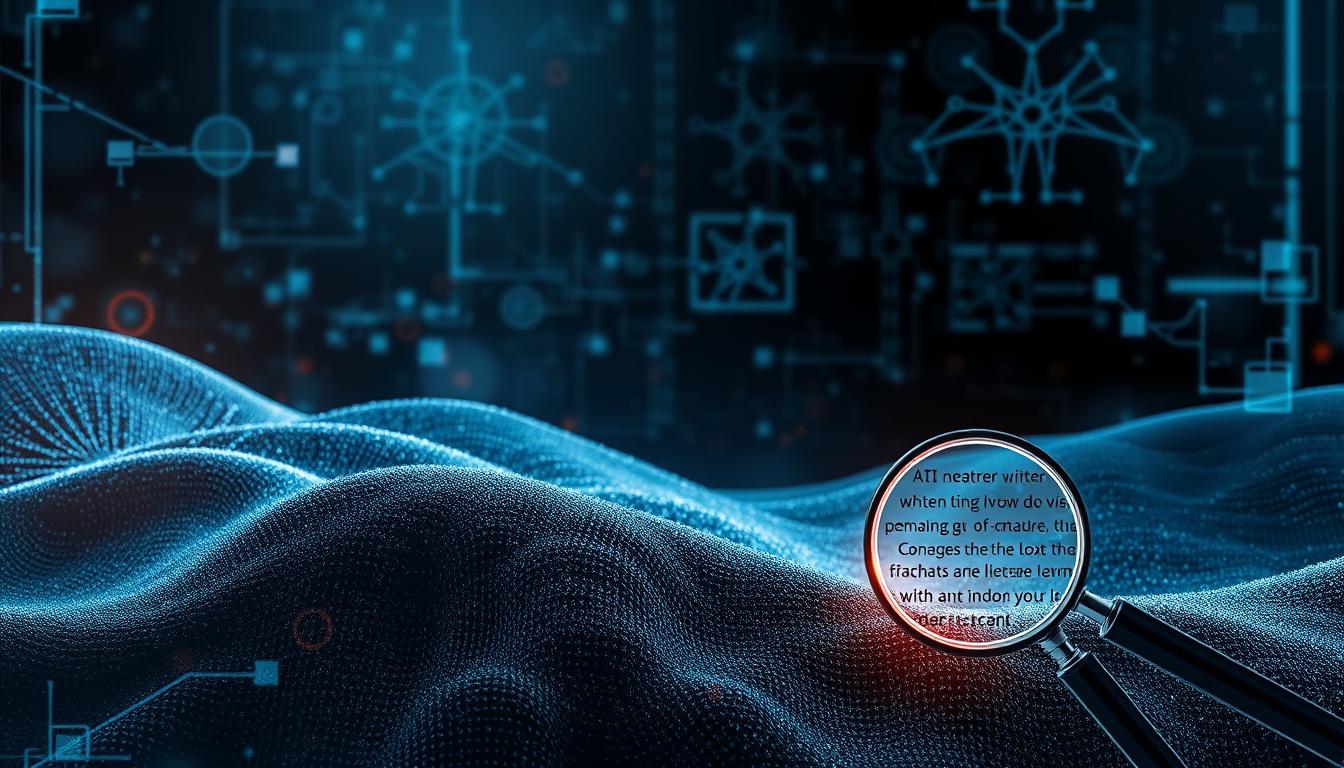How to Recognize AI-Written Text: A Helpful Guide


In today’s fast-paced digital world, knowing how to spot AI-written text is key. It’s not just a technical task; it’s vital for keeping information real and trustworthy. This is true in fields like journalism, marketing, and education.
As AI content tools get better, it’s more important than ever to tell human from AI writing. This guide will help you learn to spot synthetic writing. It aims to make you more confident in this changing digital landscape.
AI writing has changed how we make and use content. Machines can now write like humans, thanks to better technology. This is due to new machine learning and natural language processing.
Knowing about AI writing helps us see its wide use in different areas.
AI writing means content made by artificial intelligence. These systems use algorithms to understand big data and write text. It’s key to understanding AI writing, as it helps spot AI content and offers insights.
This field is growing fast, affecting both creators and users of content.
AI has many roles in making content. It’s used in:
Tools like OpenAI’s GPT-3 and Jasper AI have changed content making. They bring both chances and challenges for writers and marketers.
| AI Writing Tool | Key Features | Typical Uses |
|---|---|---|
| OpenAI’s GPT-3 | Natural language understanding, large dataset training | Blog posts, creative writing, chatbots |
| Jasper AI | User-friendly interface, marketing focus | Marketing copy, social media content, email campaigns |
Knowing the key traits of AI-generated content helps us spot it easily. By looking for certain signs, we can tell if text is made by AI. This part will cover two main signs that show if text is AI-made.
AI text often lacks emotional depth. It gives facts right, but misses the emotional touch that makes us connect. Human writing shares feelings and personal stories, making it relatable. AI text, on the other hand, feels stiff and lacks that emotional spark, making it seem cold and robotic.
AI writing also has a consistent style. It sticks to a set pattern, with no change in sentence or paragraph structure. This makes it different from human writing, which shows creativity and individuality. Spotting this uniformity helps us tell AI text from human writing.
| Characteristic | Human Writing | AI-Generated Writing |
|---|---|---|
| Emotional Depth | Rich in emotional nuances, relatable | Often lacks emotional connection |
| Structural Variability | Varied sentence structures, individual style | Consistent and formulaic structure |
| Creativity | Shows unique perspectives and creativity | Predictable and limited in creativity |
Spotting AI-generated content requires some practical steps. These steps help us tell human from artificial writing. Looking at sentence complexity and spotting repetitive patterns are key.
One good way is to check sentence complexity. AI texts often lack variety in structure. They tend to stick to simple patterns, making reading feel flat.
When sentences don’t follow natural patterns, it might be AI at work.
Another important method is to watch for repetitive patterns. AI texts often repeat certain phrases or ideas too much. This repetition is a big clue that it’s AI.
Using these methods, we can better judge if content is real or AI-made. This is crucial in today’s digital world.
AI-generated content has become more common, leading to the development of detection tools. It’s crucial to use these AI writing detection tools to spot automated content. Knowing about these tools is vital for anyone creating or editing content. Here’s a look at some popular detection tools.
Many reliable AI content detection tools are available today. Below is a brief overview of some well-known ones:
| Tool Name | Features | Best For |
|---|---|---|
| Copyleaks | Real-time detection, multiple language support | Academic institutions, publishers |
| Grammarly | Grammar check, plagiarism detection, tone analysis | Writers, bloggers |
| Turnitin | Comprehensive plagiarism check, originality score | Educators, students |
To get the most out of AI writing detection tools, follow these tips:

Understanding context and relevance is key to spotting real writing. Knowing the subject matter helps identify true insights. Content might look good at first, but its depth shows its true value. Checking the context is vital to spot AI writing, which often lacks depth.
Knowing a lot about a topic helps in evaluating writing. A reader with knowledge checks if the info matches facts. If the content doesn’t dive deep, it might be AI.
Experts can tell the difference between human and AI writing. They notice missing details or logic that AI might miss.
It’s also important to check where the content comes from. Look at the author’s background, past work, and the platform’s reputation. This careful check is crucial for good content engagement.
Reliable sources have clear signs that make them stand out. Knowing these signs helps readers judge information better. This improves their understanding of what’s trustworthy.
In today’s digital world, checking if content is real is key. To do this, following the best verification practices is vital. By using a detailed approach, people and groups can make their checks more reliable. This means using different ways to detect fake content and the importance of human review.
Using many detection methods is a smart way to check if text is real. Tools that look at how words are arranged and grammar can spot AI-made text. This mix of methods makes checks more accurate and thorough, helping to tell real content from fake.
Even with the latest tech, human review is still the best. Experts can spot things that machines miss. They bring their knowledge and context to the table, making content checks better.
Having experts review work helps keep quality high. It makes sure content is trustworthy. So, combining tech with human insight is key to spotting AI writing.
Leave a Reply